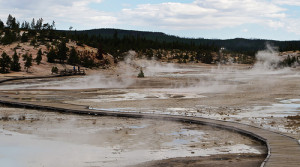
Researchers studied microbial mat metagenomes from Yellowstone’s Norris Geyser Plain. Creative Commons Attribution-Share Alike 2.0 Generic License by InSapphoWeTrust
When a third branch to the Tree of Life was proposed several decades ago, the evidence used to support the need to recognize the kingdom Archaea came in the form of two divisions of organisms that could not be categorized as Eukaryotes or Bacteria. Since then, several more archaeal phyla have been recognized, many of them through microbial field studies conducted in extremophilic environments such as Yellowstone National Park in Wyoming.
A report published online November 15, 2012 in The ISME Journal now suggests the presence of still another phylum, Geoarchaeota.
The work was led by longtime DOE Joint Genome Institute collaborator Bill Inskeep of Montana State University, and was based on metagenomic studies conducted on acidic iron-oxide microbial mats from the 100 Spring Plain at the Norris Geyser Basin in Yellowstone. The DOE JGI sequenced these samples as part of a larger project under the aegis of the Community Sequencing Program focused on several sites in Yellowstone.
The de novo assemblies revealed a novel archaea as a dominant member of the microbial mat community, one that did not fit into existing any Archaea phylum.
“Analysis … reveals a dominant archaeal population with novel strategies for energy conservation and oxygen respiration,” the team reported. “Evidence is provided here that these organisms are members of one the earliest currently known lineages of the domain Archaea, and that members of this phylum- level group are limited primarily to thermophilic habitats.”